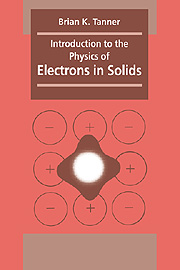Book contents
- Frontmatter
- Contents
- Preface
- Acknowledgements
- 1 The classical free electron model
- 2 Quantum mechanical free electron model
- 3 Application of the Fermi gas model
- 4 Energy bands
- 5 Experimental evidence for band structure and effective mass
- 6 Electrical conduction in semiconductors and insulators
- 7 Semiconductor devices
- 8 Localized electrons
- 9 Magnetism
- 10 Superconductivity
- Appendix 1 Elements of kinetic theory
- Appendix 2 Elements of statistical mechanics
- Appendix 3 Derivation of the Landé g factor
- Index
5 - Experimental evidence for band structure and effective mass
Published online by Cambridge University Press: 05 June 2012
- Frontmatter
- Contents
- Preface
- Acknowledgements
- 1 The classical free electron model
- 2 Quantum mechanical free electron model
- 3 Application of the Fermi gas model
- 4 Energy bands
- 5 Experimental evidence for band structure and effective mass
- 6 Electrical conduction in semiconductors and insulators
- 7 Semiconductor devices
- 8 Localized electrons
- 9 Magnetism
- 10 Superconductivity
- Appendix 1 Elements of kinetic theory
- Appendix 2 Elements of statistical mechanics
- Appendix 3 Derivation of the Landé g factor
- Index
Summary
At the beginning of the previous chapter, we reviewed some experimental data which could not be explained using the free electron model. While the Hall effect unequivocally indicates the breakdown of the free electron model, it does not provide direct evidence for the existence of energy bands. There are, however, a number of techniques which do provide a direct measure of the energy gaps and the density of states.
Optical techniques for band structure measurements
Infra-red absorption in semiconductors
The first technique is both the easiest to understand and the easiest to perform experimentally. If one looks at a piece of polished silicon or germanium, it has the appearance of a metal. However, if thinned to below a few micrometres in thickness a piece of silicon is translucent, having a red appearance. A certain amount of light is transmitted in the red end of the spectrum. If one goes further into the infra-red, we find that these semiconductors are transparent.
Monochromatic radiation can be obtained from the continuous spectrum of infra-red radiation emitted by a hot filament by use of a diffraction grating spectrometer. The intensity transmitted through the semiconductor is measured as a function of wavelength, and, as illustrated in Fig. 5.1, a very abrupt drop in transmission is observed at a frequency characteristic of the semiconductor. For germanium and other common semiconductors this ‘absorption edge’, as it is called, occurs at around 1–2 μm wavelength. This is in the near infra-red.
- Type
- Chapter
- Information
- Introduction to the Physics of Electrons in Solids , pp. 98 - 110Publisher: Cambridge University PressPrint publication year: 1995

